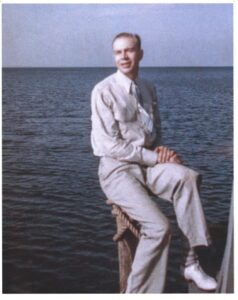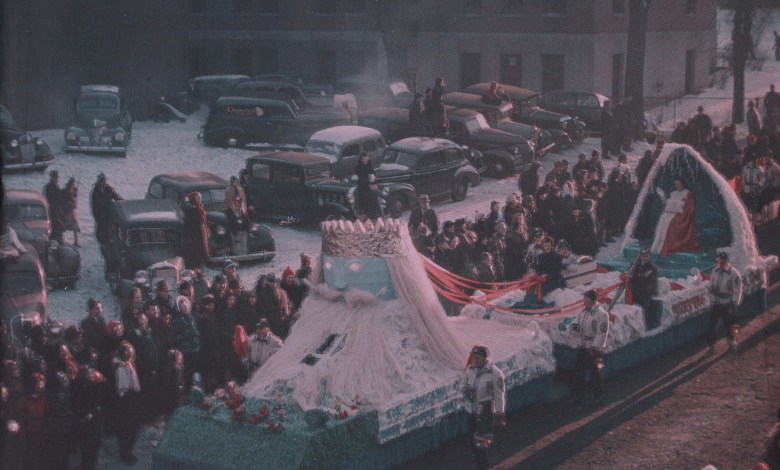Film Salesman and Photographer was on a Mission.
William Snell was a direct descendant of Stukely and Juliana Westcott in the tenth generation: William Wescott Snell10, Anna Wescott 9, Ira Wescott8, Ira Wescott7, Joseph Westcott 6, James Westcott5, Thomas Westcott4, Jeremiah Westcott3, Jeremiah Westcott2, Stukely Westcott1.
This feature in the January 2023 Minneapolis Star Tribune tells the story of William Snell’s efforts to popularize color photography before there was Kodachrome:
Earliest color photos of St. Paul Winter Carnival
make their way back to Minnesota
By Richard ChinIn 1940, William Wescott Snell was a young man on a mission: to make color photography accessible to amateur photographers. The Minneapolis man was a salesman for the Dufaycolor, an early color film promoted by a British company and based on a film process invented by a Frenchman, Louis Dufay. Snell traveled from city to city in his sales territory, which included Minnesota and the Dakotas, selling Dufaycolor film and processing to drugstores. To demonstrate “natural color film,” he often took snapshots of local events. And in January 1940 he aimed his Voigtländer camera at the most colorful event of the month – the St. Paul Winter Carnival Parade.
1940 St. Paul Winter Carnival Parade, one of eight photos shot by William Snell using Dufaycolor, an early color film process (Minneapolis Start Tribune).
Snell shot eight frames, capturing ornate floats, protesters in fanciful costumes, Winter Carnival royalty, and crowds in thick wool coats and zippy fedoras. Background buildings that survive today show that the 1940 parade moved along Summit Avenue, up to the Minnesota State Capitol, and then downtown on Cedar Street. (Today, the route is limited, going via W. 7th Street to Rice Park in downtown St. Paul.)
Despite Snell’s best intentions, Dufaycolor was ultimately not a success. Like dozens of other color film processes promoted in the early 20th century, it was eventually eclipsed by the technically superior Kodachrome, according to film historian Robert Shanebrook, a former longtime Kodak employee of Rochester, N.Y.
Being unemployed, Snell started selling floor cleaning machines. Eventually he moved to California where he started his own business selling commercial cleaning supplies and machines. “He was always kind of a salesman for something,” said Snell’s daughter, Diane Snell Freburg.
Snell died in 1993 at the age of 86 [in Anaheim, California]. And the photos he took of the colorful parade so long ago are forgotten to this day. Freiburg recently came across her father’s film. “I’m 82. I kind of wrap things up,” said Freburg, who lives in Oregon.
Born in Minneapolis the same year her father took the photos, Freburg was Snell’s only child. She has no children of her own or other relatives who would want the film. So she sent the film to the Star Tribune because she thought someone in the Twin Cities might want to see the pictures. It turns out they do.
Snell’s winter carnival photos came with the newspaper in an old Dufaycolor cardboard tube that was used to send the film to a developer. Inside was a tightly rolled 21⁄4 x 31⁄4 inch #20 strip that had already been developed. There was also a tiny note on which Snell had written: “Winter Carnival – St Paul Jan ’40.”
To be shown digitally, the film had to be scanned at West Photo in Minneapolis, one of the few places in the city that still processes film. Tom Barrett, a longtime collector of Winter Carnival memorabilia, has looked at Snell’s photos and is convinced they have historical value. “These images are amazing for two reasons,” said Barrett, the Vulcanus Rex of the 2004 Winter Carnival. “They are over 80 years old and appear to be the first color images ever taken of the St. Paul Winter Carnival, which began in 1886. “
The Minnesota Historical Society has 16-millimeter color film in its collection from the 1938 or 1939 Winter Carnival, according to Jennifer Huebscher, the Historical Society’s curator of photography and moving images. But the earliest color photographs it has of the event are some Kodachrome slides of the 1941 Carnival’s Ice Palace.
“The Dufaycolor images from 1940 would certainly be among the first color photos of the 137-year-old winter carnival,” said Schreiner. “I really want this in our collection.” (The Star Tribune is currently working with the Minnesota Historical Society to accomplish this.) Huebscher admits that the quality of the Snell photographs is not the best. Images aren’t as bright or sharp as later color snaps. But they do give a sense of the colors of the floats and the clothing of the participants in 1940 that didn’t exist before.
“Although the color is muted, it has held up better than the Kodacolor prints that were introduced just a few years later,” Huebscher wrote in an email. “I think it’s really cool.” For her part, Freburg said her father would be happy to see his decades-old photos today.
“He would be so tickled,” she said. “He was so proud that he had helped introduce color film.” The 2023 St. Paul Winter Carnival will take place from January 26th to February 5th. Visit wintercarnival.com for more information.
Posted April 10, 2023
David Wescott Smith, SSWDA Historian
historian@SSWDA.org
Additions and corrections are always welcome.


